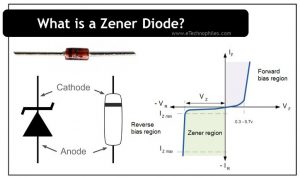Last updated on March 29th, 2024 at 12:22 pm
There is no doubt that the Zener diode is one of the most widely used diode types. Due to its wide range of applications like voltage regulation, switching circuits, clipper circuits, and surge suppressors. In this article, we will discuss its basics, construction, working, and applications.
Table of Contents
What is a Zener diode?
It is a special type of semiconductor device that is designed to operate in the reverse-biased mode. Unlike a regular diode, which breaks down at a predetermined voltage, a Zener diode breaks down at a constant voltage regardless of the current flow. This unique property makes them ideal for use in voltage regulation applications.
Zener diodes are named after Dr. Clarence Zener, who discovered the electrical breakdown effect in 1930.
Zener voltage
It is the voltage at which the Zener diode starts conducting current, and operates continuously in the reverse-bias mode without getting damaged. This voltage can vary from 2.4 V to about 200 V; it can go up to 1 kV. The maximum voltage for the surface-mounted device (SMD) is about 47 V.
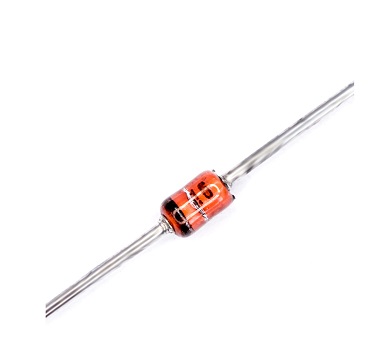
Circuit symbol
It is enclosed in a small glass encapsulation. It has a band around one end that denotes the diode’s cathode side.
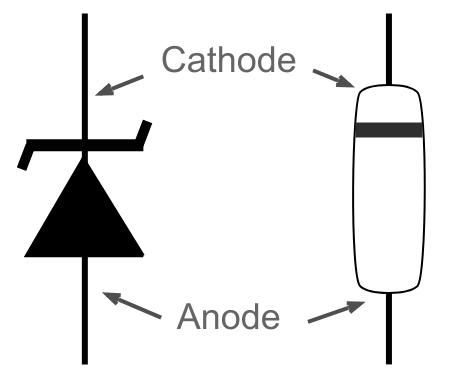
What is the reason for the ‘Z’ symbol in a Zener diode?
The Zener diode is named after the scientist Clarence Zener, hence the ‘Z’ symbol is used with it.
Unlike a regular diode, which only conducts current in one direction, a Zener diode can conduct current in either direction when it is reverse-biased above a certain voltage known as the "Zener voltage".
Working
Zener diodes are designed to operate in the breakdown region. In forward-biased conditions, it works like a normal diode. In reverse bias conditions, current starts flowing through the diode if the reverse voltage reaches the reverse breakdown voltage.
The figure below shows a circuit, in which a Zener diode is connected across a load. A series resistor Rs is connected to the circuit. It determines the maximum current that is allowed to flow through the circuit.
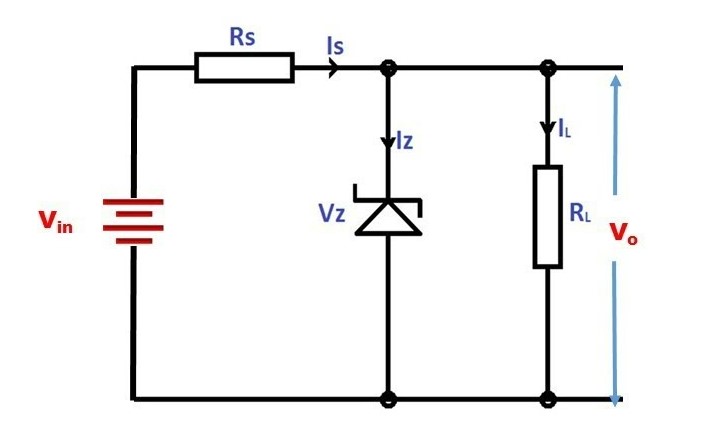
For example, if a circuit is designed to operate at 5 volts but the power supply fluctuates between 4 and 6 volts, using a Zener diode in the circuit can help to stabilize the voltage.
Commonly used Zener diodes are of the BZX55 and BZX85 series.
Types of reverse breakdown
There are two types of reverse breakdown in Zener diodes. They are ;
- Avalanche breakdown
- Zener breakdown
Avalanche breakdown
When a PN junction diode has a thick depletion layer and is moderately doped, avalanche breakdown occurs. When a high reverse voltage is applied across the diode, the electric field across the depletion region increases. This electric field breaks the bond and releases free electrons.
These electrons collide with more atoms in the junction to generate more free electrons. Thus electric current increases rapidly due to a large number of free electrons.
Zener diodes that have a Zener voltage (Vz) greater than 6V experience avalanche breakdown.
Zener breakdown
Zener breakdown occurs when the PN junction diode has a thin depletion region and is heavily doped. This narrow depletion region begins to produce a powerful electric field when reverse-biased voltage is applied. When this voltage reaches the Zener voltage, the electric field forces electrons to come out of the covalent bond.
Thus free electrons are generated and electric current is produced. Zener breakdown occurs when the electric field expands significantly but stays limited, making it difficult for numerous charge carriers to accelerate.
Avalanche breakdown vs Zener breakdown
The major difference between avalanche breakdown and Zener breakdown is the breakdown voltage. Avalanche breakdown occurs at a voltage greater than 8V whereas Zener breakdown occurs in the voltage range of 5-8 V or less than 5V. Other differences are given in the table below.
| Characteristics | Avalanche breakdown | Zener breakdown |
| Tunneling effect | No tunneling effect | The tunneling effect takes place |
| Doping | Minimum at PN junction | High at PN junction |
| Impact on junction | Junction gets damaged permanently | The junction reverts to normal when voltage is removed |
| Electric field | Weak | Strong |
| Temperature coefficient | Positive (Voltage directly proportional to temperature) | Negative (Voltage inversely proportional to temperature) |
| Depletion region | Thick | Thin |
| Electric field | Weak | Strong |
V I characteristics
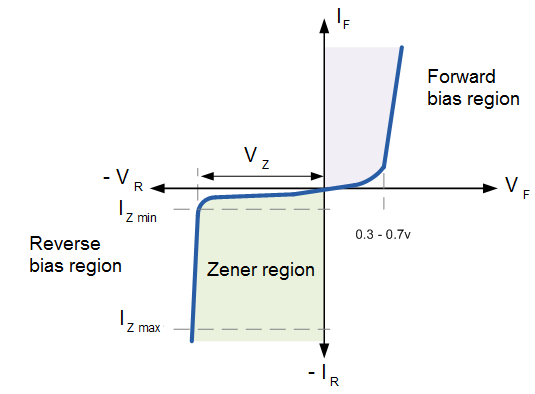
The figure above shows the V-I characteristics of the Zener diode. The forward characteristics of Zener diodes are similar to that of ordinary PN junction diodes. But in the reverse bias condition, as reverse voltage increases, a small reverse saturation current flows through the diode due to minority carriers.
When this reverse voltage reaches the Zener voltage, the reverse current increases significantly and abruptly. The diode starts conducting by maintaining a constant terminal voltage.
General parameters
Different parameters of the Zener diode are given in the table below.
| Vz (Zener voltage) | 2.4 V – 100 V, can reach up to 1 kV, surface-mounted device’s (SMD) limit of roughly 47 V) |
| Izmax (Maximum current) | 200μA to 200 A |
| Izmin (Minimum current for breakdown) | 5 mA and 10 mA. |
| Power | Vz*Iz Typical values are 400 mW, 500 mW, 1 W, and 5 W; for surface mounted, 200 mW, 350 mW, 500 mW, and 1 W are typical. |
| Voltage tolerance | 5% |
Applications
Voltage regulator – To keep the output voltage constant, it is used as a shunt voltage regulator.
As reference elements – Since it gives constant output voltage, it can be used as a reference element in electronic circuits.
As surge suppressors – To suppress voltage spikes.
Clipper circuits – They can be used in clipping circuits to clip input sine waves.
FAQs
Why does the Zener diode need to be heavily doped?
For its proper functioning, it must be heavily doped. This means that there are a large number of impurities present in the material. The impurities help to create a depletion region near the junction, which allows the current to flow more easily.
Why is a Zener diode used in reverse bias?
They are specifically designed to operate in reverse bias conditions. When it is reverse-biased, it allows a controlled and precise breakdown to occur at a specific voltage known as the Zener voltage (VZ).
